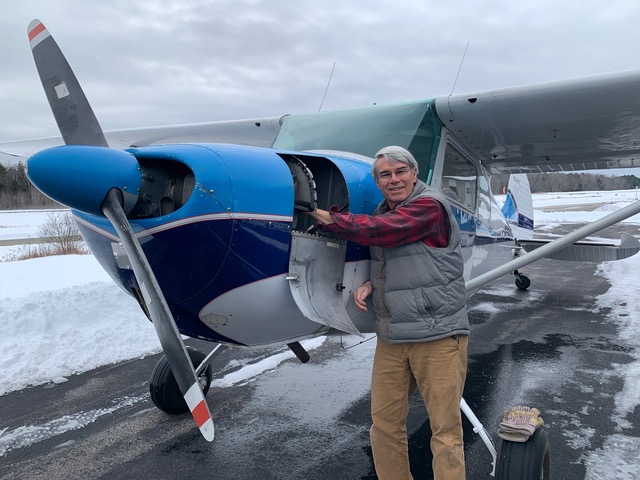WORTH THE READ: JOHN SOWLES GUEST EDITORIAL
Our many RAF supporters have such vast and varied experience, and we’re capturing some of their words of wisdom to share with you. This month’s guest editorial is by John Sowles, a longtime pilot and RAF Supporter from Maine.
Bridging the Conservation Divide:
I’m neither the owner or CEO of a major aviation manufacturer nor a 10,000 hour bush pilot. But I do want to share my experience assisting the RAF in opening up a remote airstrip in the North Maine woods. Hopefully, it will help others as we try to save access to a dwindling number of airstrips.
The RAF is remarkable in many ways; it was born of an audacious idea by a bunch of bold risk takers over a coast-to-coast geography, negotiating with government bureaucracies, private property owners and environmental/conservation organizations. Objectively, I’d say they were a bit short of furnishings “upstairs”. But look at what they have accomplished!
My introduction to the RAF began soon after its founding at a dinner with a group of local pilot friends – Steve Williams, Lisa Reese, and Maine Liaison Andy Rowe – where the McKennas explained their vision and goals. At that point in my life, most of my flying had been on floats collecting samples for the State from waterbodies that were difficult to access by truck. I really enjoyed and appreciated getting away to remote areas and relying on nobody but myself. I had never given it a thought that land-based airstrips could provide a similar sense of independence, self-reliance, and peacefulness as the ponds, lakes and rivers I visited. The possibility of a land-based experience intrigued me and I became involved.
Right off the bat, I was afforded a front row seat on a long journey with RAF as we worked to reopen an abandoned airstrip in northern Maine. From the mid ‘60s and into the 80s, Maine’s north woods was hit with a spruce budworm infestation that destroyed hundreds of millions of dollars of wood having widespread negative impact on the economy of Maine. To combat the budworm, International Paper and the Maine Forest Service built a 3,200-ft paved airstrip to handle converted WWII bomber spray planes.
After the budworm infestation passed, Red Pine Airfield was abandoned. Its location adjacent to the St. John River made for a popular camping spot for canoeists and hunters. In 1998, as part of a large land conservation deal, ownership of Red Pine passed to The Nature Conservancy. For liability reasons, the strip was X’ed out. Camping and land-based vehicle access remained.
At that fateful dinner, it leaked out that I happened to be a Trustee of the TNC in Maine. “Could I help?” Soon I found myself in an awkward position between two organizations that on first glance might appear in conflict. At the time, conservation organizations were not especially known for opening access, much less motorized access. But Red Pine had been used for recreation for decades by locals.
When TNC ‘X’ed it out, it left a bitter taste with locals at a time when organizations like TNC were trying to repair community relations. Upon closer look, the RAF and TNC hold a lot in common. Both believe in supporting communities while achieving their mission. In TNC’s case, much of their land is open to commercial harvest, hunting and fishing, thereby supporting local economies. In RAF’s case, RAF provides stewardship value to the property owner. In this way we indirectly serve the non-aviation communities as well. Both organizations are respectful. Both seek ways to collaborate. Both are committed to conserving natural area experience. And both appreciate local community values.
Because TNC looked at the airfield as a potential attractive nuisance and liability, RAF made the case that we could manage that risk while benefiting a wide constituency. And through gentle conversation, I think we changed the balance sheet from negative perceptions of aviation to positive. Helpful in our conversations were the RAF Code of Ethics, data showing the comparable environmental impacts of aircraft vs land-vehicles, enabling TNC staff to access their property more frequently, ensuring a landing area for emergency evacuations in a remote area of the state, as well as for pilots transiting a large tract of unoccupied forest. We also were willing to concede about 700 feet by shortening the runway so that it would not infringe on the river protection corridor.
I’ve always believed that people can’t appreciate places if they are locked out. By being present and maintaining a clean and safe area, Red Pine can continue as a critical low impact asset for pilots and many other recreationalists. I want to acknowledge Andy Rowe, Steve Mason and Bill Sylvester as partners in this journey and Steve Williams and Lisa Reese for that dinner so many years ago. They, along with TNC staff, were a pleasure to work with.
My “take aways” are three:
- What the RAF does and how it does it is its secret to success. It requires a clear vision that provides benefits beyond RAF directly.
- The RAF does it by being supportive and respectful rather than confrontational; listening to and addressing landowner concerns and supplying facts and rational positions, and
- Patience, LOADS of patience and perseverance. Finally, after over 12 years of work, Red Pine reopened in 2021.
In closing, I believe that for all you out there who think you can’t make a difference, think again. We all have something to offer.

John Sowles flies a Cessna 170, a Champ, and a TaylorCraft. His career was in testing and ensuring water quality in the United States and abroad. He’s a former trustee for The Nature Conservancy and continues to do volunteer work for them. John retired from his scientific profession, but still consults in the Dominican Republic and Kenya.
Submitted January 23, 2024.

I have been a longtime lover of Red Pine since my young son and I camped out there in the mid 80’s. On our first trip the game warden came by shortly after we landed. He could not have been nicer suggesting we enjoy the night sky. He went on to tell us how far we were from the nearest paved road and the nearest electric light. The night sky was like nothing we had ever seen before. Have made several trips back since it reopened. I want to thank the RAF members and especially Steve Mason who kept me updated on its progress over the years.
Tom
Very inspirational! I’m proud to be an RAF member and Volunteer. It is all worth it…
John you get the core values of the RAF—Patience, patience, patience and always take the high road. As you’ve seen, it pays off. Thank you for your hard work and insights to get Red Pine opened. That’s a great accomplishment
Great write up John! We have one in Idaho we have been trying to get reopened for probably 25 years. You’ve inspired me to keep trying.